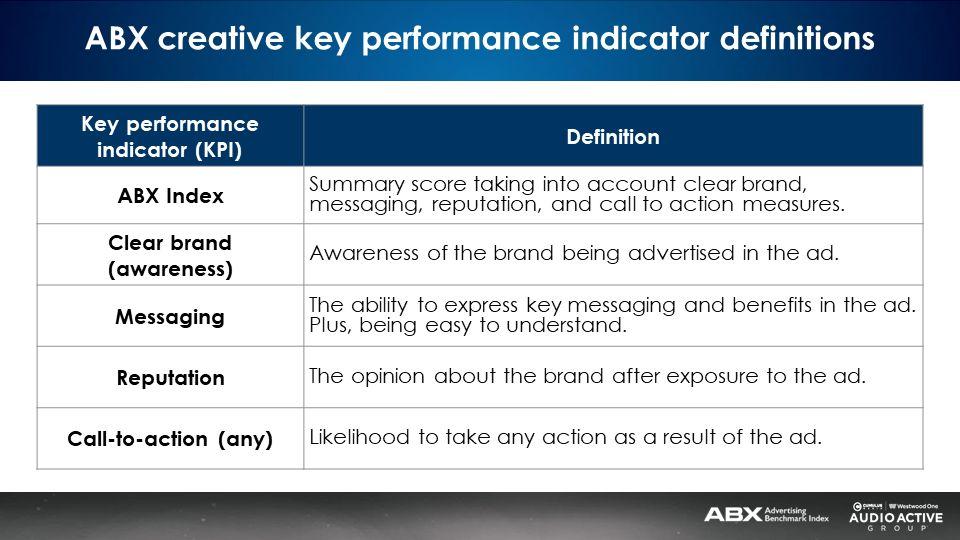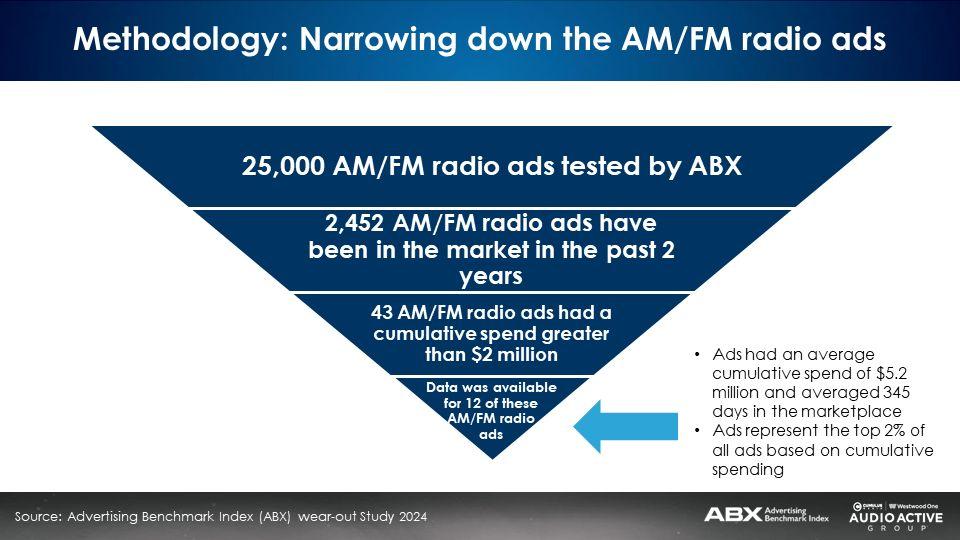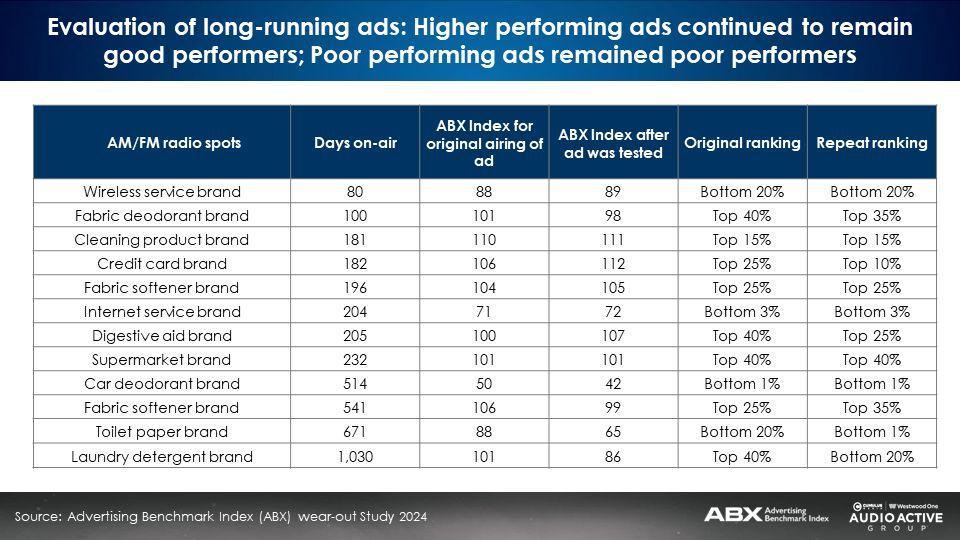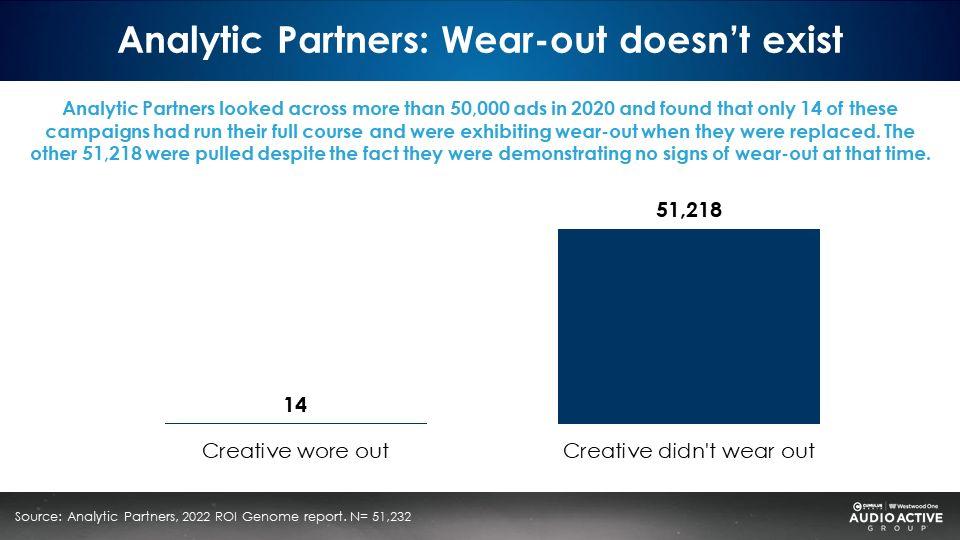ABX/RAB Radio Creative Wear-Out Study Validates Mark Ritson’s Conclusion That Consumers Don’t Get Tired Of Ads, Only Marketers Do
Click here to view a 9-minute video of the key findings.
Click here to download a PDF of the slides.
One of the most frequently asked questions the Radio Advertising Bureau receives on audio creative involves wear-out. Wear-out is defined as the point where creative testing declines from its peak due to message frequency fatigue.
To explore whether wear-out is an issue, the Radio Advertising Bureau commissioned a study from ABX Advertising Benchmark Index, a global leader in creative testing, with half-a-million ads evaluated to date.
Key findings:
- Consumers don’t get tired of ads, only marketers do: The ABX AM/FM radio creative study for the RAB proves legendary marketing professor Mark Ritson was right.
- Wear-out of AM/FM radio ads is virtually non-existent: Only two of 25,000 ads showed a decline in some creative effectiveness metrics. Two major creative effectiveness measures, branding and messaging, showed no wear-out.
- The two ads showing differences were at the top end of cumulative spending and time in market: Two years in market and $8M+ of spend is where creative effectiveness might start to wane.
- Repeat testing of ten of the twelve longest running AM/FM radio ads reveals no statistically significant erosion.
- The giants of marketing effectiveness and creative testing conclude wear-out is non-existent: Take it from Les Binet/Sarah Carter, ABX, Kantar, System1, and Analytic Partners.
How ABX conducted their study

Gary Getto, President of ABX, a leading creative testing firm, found wear-out of AM/FM radio ads is extremely rare.
Led by President Gary Getto, ABX has evaluated hundreds of thousands of ads across all media including online video, AM/FM radio, TV, OOH, print, and all digital formats. The ABX Index is the summary score which combines four responses: clear brand, messaging, reputation, and call-to-action.

To determine if AM/FM radio ads exhibit performance decay, the RAB commissioned ABX to examine their dataset of 25,000 AM/FM radio creative tests to unearth ads that had been running for at least two years with a cumulative national spend of $2M+. This yielded only forty-three AM/FM radio ads, twelve of which had been evaluated by ABX.

Just two ads had statistically significant score erosion
Out of 25,000 ads, only two could be considered as suffering from wear-out. Most ads held their previous scores.
Great performing ads stay strong performers. Poor performing ads remain poor performers. Repeat testing of ten of the twelve longest running AM/FM radio ads reveals no statistically significant erosion.

The giants of marketing effectiveness and creative testing conclude wear-out is non-existent
In an article for Marketing Week, legendary marketing professor Mark Ritson reviewed findings from global leaders in effectiveness measurement who all conclude wear-out does not exist.
A leader in marketing effectiveness, Analytic Partners examined more than 50,000 ads and found that only 14 of these campaigns had run their full course
Just 14 ads exhibited wear-out when they were replaced. The other 51,218 were pulled despite the fact they were demonstrating no signs of wear-out.

System1, global leader in creative testing, reveals scores hold steady month one out to two years
Ritson explains, “The average rating for an ad in the System1 database during the first month it airs is 2.2 stars out of 5. The average rating for an ad that has been continuously shown for more than two years is 2.2 stars. That performance remains constant right across the thousands of ads System1 measures. The only (exception) is with ads that focus on a specific event, for example, a FIFA World Cup ad that is shown after the event has ended.”
Kantar, a major force in marketing effectiveness, reports there is no relationship between performance and length of time on air
Les Binet and Sarah Carter: No evidence of wear-out
The trusted source for agency account planners is the book How Not To Plan: 66 Ways To Screw It Up. In it, authors and marketing effectiveness gurus Les Binet and Sarah Carter report, “Most ads don’t get much chance to wear out nowadays. Most TV ads are only seen a handful of times. Prompted ad awareness scores are typically well under 40%. And even when TV weights were higher, there was little evidence of good campaigns wearing out. A major manufacturer once reviewed thousands of econometric analyses and concluded that there was no evidence of wear-out in any of their campaigns they’d run anywhere in the world. Our own econometrics tell the same story.”
Mark Ritson takeaways for marketers
1. “Learn patience: The most obvious implication of the lack of wear-out is the need for greater patience on the part of marketers with respect to their creative execution. As noted above, while wear-out does not exist for most consumers, it is alive and well in the world of most marketing departments.
In another implication of market orientation, marketers must learn the patience of the market. They look at their ads with such focus and passion that – inevitably – they grow tired of the work long before most of their target market has even become accustomed to it. This results in campaigns being pulled long before they have had time to develop and impact the market fully and leads marketers to replace these high-potential ads with new campaigns that – if the hoary old data is to be believed – are likely to be less effective four times out of five.
2. New marketers should resist new campaigns The single most common move for new senior marketers taking over at a brand is to put the account under review and start thinking about a Big New Campaign. I can count on one hand the number of senior marketers who entered a new role, looked at the existing advertising campaign and agency partner and – with the help of research rather than their lower intestine – opted to keep running things as is. Yet this wear-out data demonstrates very clearly the likely value in doing just that… more often than not, the existing campaign is likely still working and the new marketer has bigger, more important boulders to move first as they start their tenure.
3. Dust down old ads: Armed with this data, marketers should also be raiding their corporate libraries for the dusty VHS tapes of their old brand ads. Sure, you can build something new. But that does not mean it’s the right move. Your predecessors from the 70s and 80s were just as smart as you, they just dressed badly. Hell, there is a 50/50 chance they were smarter.
Don’t forget to look backwards before you head forwards. Sitting in your archive might be a wonderful ad that, with a modern tweak, can work again. Three times I have suggested to clients that they re-run old iconic ads and three times my suggestion has been met with blank stares. Why would we run an old, proven, already paid-for, much loved ad when we can create something completely new and unproven?
4. Save next year’s creative budget to spend on media: The average big new campaign will spend 20% to 30% of its annual budget on execution, leaving the remaining 70% for media investment. But what if you knew you could run your ad for longer? That would change your approach, right? For starters, you’d spend more in year one because you know this campaign will be running for many years. You’d spend more on testing too because the stakes are so much higher and longer than they used to be. But then you can look forward to many years where close to 100% of your ad budget becomes working media investment in the years that follow.
… But if you accept wear-out does not exist – if you go for better, longer creative – you just earned yourself an extra 25 points of SOV to win the game, versus your new-ad-loving, underspending competitors. This is a HUGE point.”
If wear-out is a non-issue, how can I enhance creative effectiveness?
Look no further than the Audio Creative Best Practices Handbook. We have distilled insights from marketing effectiveness and creative strategy work from industry giants into one guide: Cumulus Media | Westwood One Audio Active Group®’s comprehensive Audio Creative Best Practices Handbook.
Key findings:
- Consumers don’t get tired of ads, only marketers do: The ABX AM/FM radio creative study for the RAB proves legendary marketing professor Mark Ritson was right.
- Wear-out of AM/FM radio ads is virtually non-existent: Only two of 25,000 ads showed a decline in some creative effectiveness metrics. Two major creative effectiveness measures, branding and messaging, showed no wear-out.
- The two ads showing differences were at the top end of cumulative spending and time in market: Two years in market and $8M+ of spend is where creative effectiveness might start to wane.
- Repeat testing of ten of the twelve longest running AM/FM radio ads reveals no statistically significant erosion.
- The giants of marketing effectiveness and creative testing conclude wear-out is non-existent: Take it from Les Binet/Sarah Carter, ABX, Kantar, System1, and Analytic Partners.
Click here to view a 9-minute video of the key findings.
Pierre Bouvard is Chief Insights Officer of the Cumulus Media | Westwood One Audio Active Group®.
Contact the Insights team at CorpMarketing@westwoodone.com.